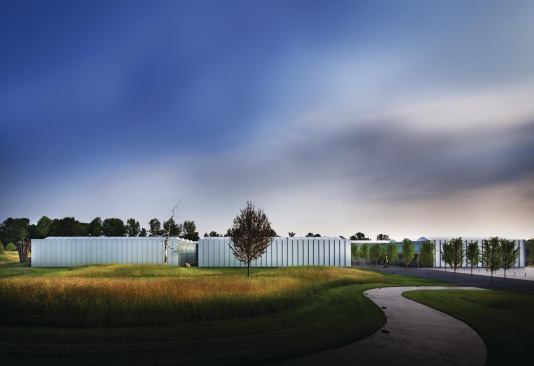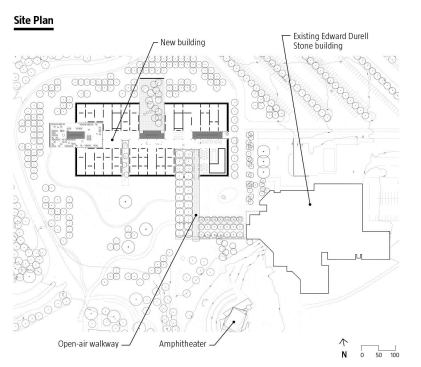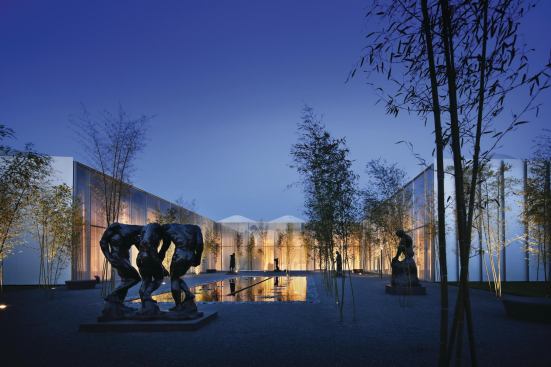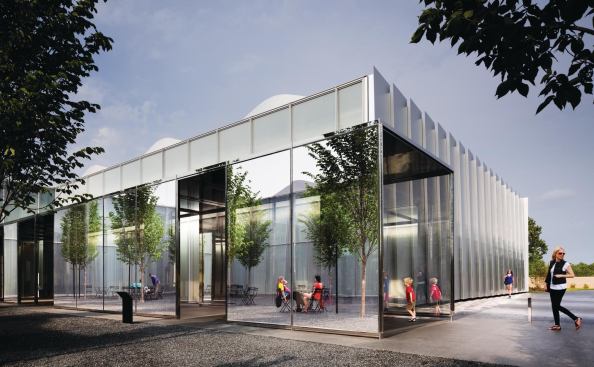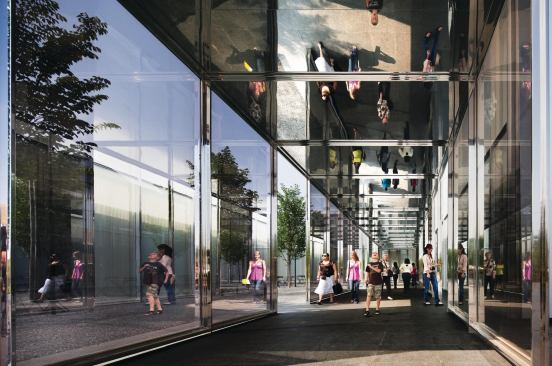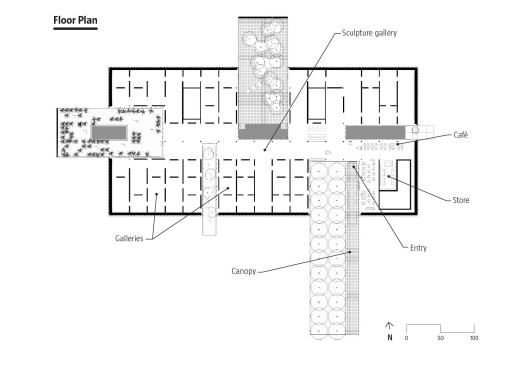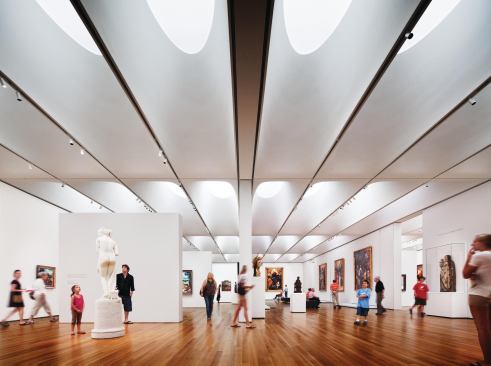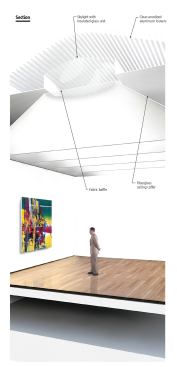Scott Frances
The new building at the North Carolina Museum of Art provides mo…
Since he became the North Carolina Museum of Art’s director in 1994, Lawrence Wheeler has lobbied for an expansion to the Raleigh, N.C., institution’s 1983 Edward Durell Stone–designed building (completed after his death). This year—after an fundraising campaign to get more than $70 million from state, county, and city funds, as well as from private donors—his vision was finally realized with the opening of a new 127,000-square-foot building by New York–based Thomas Phifer and Partners.
Wheeler’s vision called for a light-filled building open to the surrounding landscape and free to the public, in which art would be presented in a less constricted environment than the existing building allowed; it would also be a destination for anyone seeking a place of beauty and serenity. This became partner-in-charge Thomas Phifer’s mandate. The once rural site is now a museum park, veined with hiking and bike trails leading to site-specific art installations.
A Southerner himself, Phifer sought to acknowledge the region’s historic attachment to the land, designing a museum that would be an iconic landmark for the state without overwhelming the site’s established identity. “The goal from the beginning was to create a beautiful environment for experiencing the museum’s diverse collection of art, both in galleries and out in the landscape,” Phifer says.
Toolbox
It’s well known that UV light degrades pigment and textiles over time, making daylight a problematic fit with museum spaces. Thomas Phifer addressed this problem by creating a lighting budget not defined by costs, but by how many hours over the course of a year artwork can safely be exposed to natural or electric light.
The allowable times—i.e., the hours of daylight per day multiplied first by the number of foot-candles of light directed at each artwork per hour, and then by 365 days in the year—range from 15,000 foot-candle hours per year for light-sensitive works up to 90,000 foot-candle hours per year for public spaces and most sculptures.
Using Rhino software for 3D modeling, complex computations revealed a strategy for achieving the lighting goals, using, for the most part, low-tech materials in carefully calibrated arrays.
On the roof, louvered domes hover above 362 skylights, oriented to allow only indirect north light into the galleries. The skylights also have an interlayer for UV protection. Deep, oval-shaped fiberglass coffers direct the tempered light downward into oculi, which are covered in lightweight, interchangeable fabric scrims calibrated to complete the filtering process.
Glass curtain walls are fritted to keep out UV rays while allowing visible light with a 96+ color rendering index to flood the galleries through white curtains, which range from opaque to diaphanous. Mechanically controlled roller shades can black out all daylight if desired. The multiple layers create an effect that is greater than the sum of the components.
Between the coffers and the glass walls, 50 percent of the gallery lighting is natural daylight. And to maximize energy efficiency, photocells mounted on the roof track cloud cover and sky conditions to raise and lower the shades accordingly. Temperature, humidity, and carbon dioxide levels are monitored by HVAC systems such as high-efficiency chillers to maintain human comfort and protect the artworks. An independent agent supervised the installation and will monitor performance of the environmental and mechanical systems.
Phifer’s parti is a large rectangle penetrated by smaller rectangles that represent the park’s infiltration of the building. These penetrations evolved into sculpture courtyards with reflecting pools and a garden with granite boulders from western North Carolina that are placed as sculptural pieces. Low-E–glazed window walls allow clear, untinted views from the interior galleries to art installations outside. At these points, unlike most museums, the building allows liberal access in and out, contributing to an experience that is of the land. This is reinforced by the fact that the museum is a single story: No visitor is ever isolated from the landscape.
Elsewhere, the perimeter of the one-story structure is windowless, clad with a vertical array of anodized-aluminum panels with a matte-gray finish. Each of these panels measures 5 feet 2 inches by 24 feet, which qualifies them as among the largest aluminum panels fabricated in the U.S. to date. Each panel overlaps the next at an angle, and in the resulting gap, a highly polished, stainless-steel insert reflects the sun’s rays back onto the adjacent panel. Without this detail, the solid façades would seem monolithic and impenetrable; instead, the walls seem to dematerialize as reflections of clouds and trees float across the surfaces.
What is not perceptible is that these walls are 2 feet thick. Rigid insulation occupies the exterior space behind the cladding. Conditioned air is pumped through a cavity, dispersed at the ceiling, and returned at the floor.
In addition to the window walls, 362 skylights admit natural light into the building. Waves of louvers on the roof allow only indirect northern light to enter the insulated skylights, set into deep molded coffers forming oval oculi, which are in turn covered by protective fabric scrims. The gently curving coffers prevent shadows, causing the art to seemingly emerge from the walls and pedestals into high relief.
Phifer cites Louis Kahn’s Kimbell Art Museum in Fort Worth, Texas, as a key inspiration. Kahn’s concrete barrel vaults direct daylight downward into the galleries, articulating the spaces with gently dispersed light. Phifer’s design invites comparison from which neither architect suffers. The spatial articulation and detailing of each museum has been described as austere, but both were borne of steadfast logic and disciplined execution, which translates complexity into sublime simplicity.
Project Credits / Materials & Sources
Project Credits
Project North Carolina Museum of Art, Raleigh, N.C.
Owner Department of Cultural Resources, State of North Carolina
Design Architect Thomas Phifer and Partners, New York—Thomas Phifer (partner-in-charge); Gregory Reaves (project partner); Gabriel Smith (project architect); Adam Ruffin, Katie Bennett, Christoph Timm, Jon Benner, Kerim Demirkan, Len Lopate, Eric Richey, Joseph Sevene, Danny Taft (project team)
Local Architect Pierce Brinkley Cease + Lee, Raleigh, N.C.—Clymer Cease (partner-in-charge); Jeffrey Lee (project partner); David Francis (project architect); Mac Nance (director of construction administration); Nelson Tang, Matt Konar, Juliette Dolle, Henry Newell, David Lehman, Jennifer Olson (project team)
Landscape Architect Lappas + Havener
Structural Engineer Skidmore, Owings & Merrill
Mechanical Engineer Altieri Sebor Wieber
Local M/E/P Engineer Stanford White
Natural Lighting Design Arup
Lighting Design Fisher Marantz Stone
Civil Engineering Steven Blake; Artifex-ED; Kimley-Horn Associates
Specifications Aaron Pine
Acoustics Creative Acoustics
Construction Manager Barnhill—Balfour Beatty
HVAC and Plumbing Ivey Mechanical
Electrical Watson Electric
Fire Protection ABL Fire Protection
Site Work Faulconer Construction; Valley Crest Landscaping
Masonry Whitman Masonry
Size 127,000 square feet
Total Cost $72.2 million
Materials & Sources
Canopy Linel linelsignature.com
Curtain Wall Vistawall oldcastlebe.com; Viracon viracon.com
Skylights and Louvers Supersky supersky.com; Sika Sarnafil (felt-back PVC roofing) sarnafilus.com; Unicel Architectural (louvers) unicelarchitectural.com; Fibertech (fiberglass
ceiling coffers) fibertech.net
Doors Ellison Bronze (entrances) ellison-bronze.com; Total Door (metal doors) total-door.com
Curtains Mary Bright
Millwork Triangle Casework trianglecasework.com
Furnishings Herman Miller hermanmiller.com; Fritz Hansen fritzhansen.com; Fermob USA fermobusa.com; Maharam maharam.com
Lighting Litelab Corp. litelab.com; Nippo Electric Co. nippo-web.com; Crestron Electronics crestron.com
